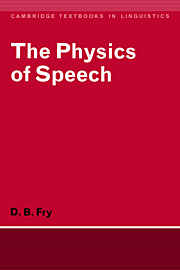Book contents
- Frontmatter
- Contents
- List of phonetic symbols
- 1 The speech chain
- 2 The generation of sound
- 3 The propagation of sound waves
- 4 Absorption and reflection of sound energy
- 5 Free and forced vibrations: resonance
- 6 The speech mechanism as sound generator
- 7 The vocal tract
- 8 Periodic and aperiodic sounds
- 9 Acoustic analysis: the sound spectrograph
- 10 Acoustic features of English sounds
- 11 Acoustic cues for the recognition of speech sounds
- Index
8 - Periodic and aperiodic sounds
Published online by Cambridge University Press: 05 June 2012
- Frontmatter
- Contents
- List of phonetic symbols
- 1 The speech chain
- 2 The generation of sound
- 3 The propagation of sound waves
- 4 Absorption and reflection of sound energy
- 5 Free and forced vibrations: resonance
- 6 The speech mechanism as sound generator
- 7 The vocal tract
- 8 Periodic and aperiodic sounds
- 9 Acoustic analysis: the sound spectrograph
- 10 Acoustic features of English sounds
- 11 Acoustic cues for the recognition of speech sounds
- Index
Summary
All the sounds discussed so far have one feature in common: they consist of a fundamental frequency plus a series of harmonics. By definition, the frequencies of harmonics are always exact multiples of the fundamental frequency and every complex tone we have considered is a mixture of frequencies which satisfy this condition. One important implication of this concerns the wavelength and hence the waveform of the sound. If the fundamental frequency is 100Hz, then the period of this vibration is 10 ms, that is to say it will cause a peak of compression every 10 ms and the peaks will be separated in space by the distance traversed in this time by sound waves in the given medium (in air, 3.4m). The waveform of the vibration will be as it is shown in Fig. 3. The second harmonic, 200 Hz, will perform exactly two cycles in the same time and when the vibration at the fundamental frequency is passing through the position of rest to begin the second cycle, the second harmonic is also about to start on the positive half of its cycle. Similarly the third, the fourth, the fifth and indeed any other harmonic will complete an exact number of cycles in the time taken by one cycle of movement at the fundamental frequency. The result is that when all the different motions are combined to give the complex wave, exactly the same pattern of movement takes place within each cycle of the fundamental and the sound has a repeating waveform, as we saw illustrated in Figs. 11 and 12.
- Type
- Chapter
- Information
- The Physics of Speech , pp. 82 - 88Publisher: Cambridge University PressPrint publication year: 1979

